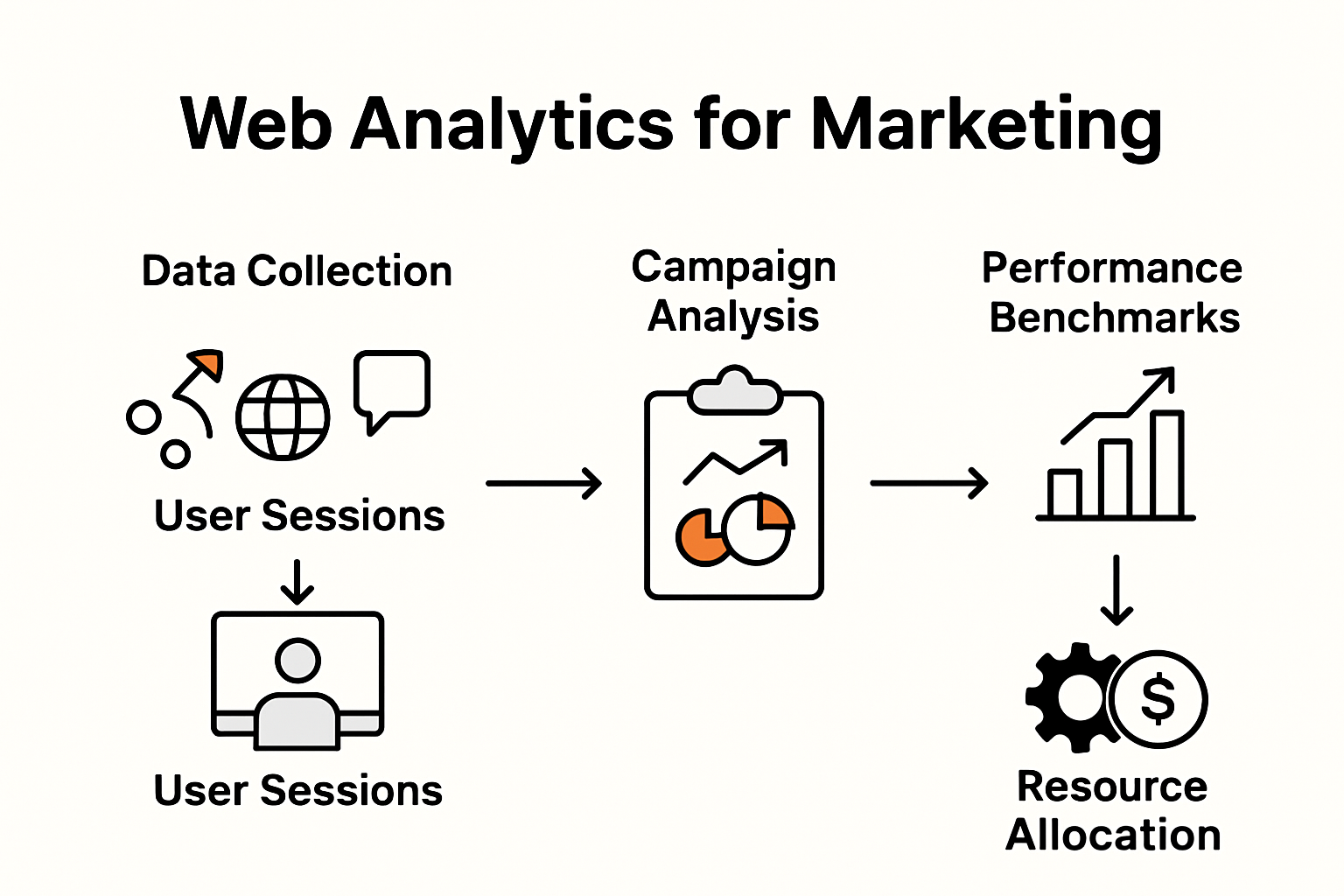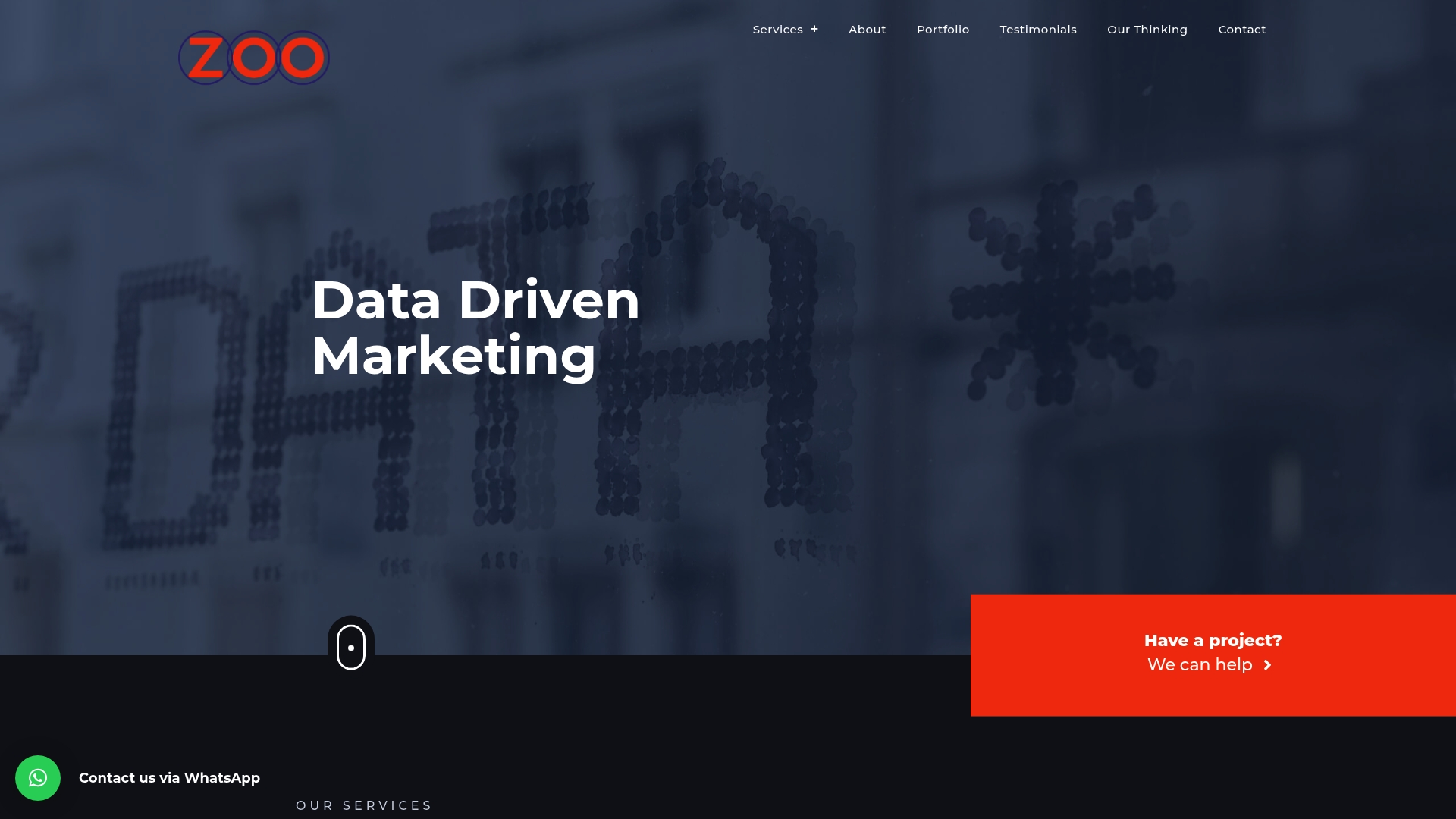Web analytics might sound like just another tech buzzword, but for local businesses trying to grow online, it can mean the difference between getting noticed and getting left behind. Now check this out. Businesses using web analytics report up to 30 percent higher conversion rates compared to those who don’t. You’d think the magic is all in the numbers and graphs, but the real game is how these numbers point straight to what your customers actually want. That is where the real advantage kicks in.
Table of Contents
- Understanding What Web Analytics Offers
- Benefits of Web Analytics for Small Businesses
- How Web Analytics Improves Marketing Efforts
- Turning Web Data into Better Business Decisions
Quick Summary
| Takeaway | Explanation |
|---|---|
| Web analytics provides critical insights. | It transforms raw data into strategic information that helps businesses optimize their digital presence and performance. |
| Understand customer behavior for better decisions. | Tracking metrics reveals how customers interact, allowing businesses to make informed decisions based on user preferences and trends. |
| Optimize marketing budgets with data. | Use web analytics to identify the most effective channels and campaigns, ensuring resources are allocated efficiently for maximum return on investment. |
| Enhance campaigns through real-time adjustments. | Analyze campaign performance to refine marketing strategies quickly, improving engagement and maximizing conversion rates. |
| Leverage predictive analytics for future planning. | By analyzing past behavior, businesses can forecast trends and anticipate customer needs, aiding in proactive strategy formulation. |
Understanding What Web Analytics Offers
Web analytics provides businesses with a powerful lens into their digital performance, transforming raw data into strategic insights that drive growth. By capturing and analyzing user interactions across digital platforms, organizations gain unprecedented visibility into how customers engage with their online presence.
The Core Mechanics of Web Analytics
At its foundation, web analytics tracks and measures website visitor behavior through sophisticated tracking technologies. Discover our comprehensive analytics guide to understand how these systems capture detailed user interactions. These tools collect critical data points including page views, user sessions, traffic sources, and conversion pathways.
According to research from Western Michigan University, web analytics offers actionable insights that enable organizations to optimize digital strategies through precise performance metrics. By examining indicators like bounce rates, session duration, and user flow, businesses can make informed decisions about their online platforms.
Transforming Data into Strategic Opportunities
Web analytics goes beyond simple number tracking. It provides a comprehensive understanding of user behavior, preferences, and potential barriers in the customer journey. Businesses can identify which content resonates most, understand traffic patterns, and pinpoint areas requiring improvement.
Key performance indicators such as conversion rates, user engagement metrics, and referral sources help companies refine their digital marketing approaches. By understanding where users come from, how long they stay, and what actions they take, organizations can develop targeted strategies that directly address user needs and preferences.
The true power of web analytics lies in its ability to translate complex data into clear, actionable insights. Whether you are a small business owner or a digital marketing professional, these tools provide the strategic intelligence needed to make confident, data-driven decisions that can significantly impact your online performance and overall business growth.
Benefits of Web Analytics for Small Businesses
Small businesses operate in a competitive digital environment where understanding customer behavior can make the difference between success and stagnation. Web analytics provides a critical toolkit for these organizations to gain strategic insights and make data-driven decisions that drive growth and efficiency.
Understanding Customer Behavior and Preferences
Web analytics offers small businesses an unprecedented window into customer interactions and preferences. Learn more about strategic marketing analytics to unlock deeper insights into your customer base. According to digital.gov, web analytics involves collecting and analyzing website data to assess performance and achieve organizational goals.
By tracking metrics such as page views, session duration, and user flow, small businesses can understand exactly how potential customers interact with their online platforms. This information reveals critical insights like which content attracts the most attention, where users spend the most time, and what potential barriers might exist in the customer journey.
Cost-Effective Marketing and Resource Allocation
For small businesses with limited marketing budgets, web analytics becomes an invaluable tool for strategic resource allocation. According to research from William & Mary Online, data analytics enables businesses to make informed decisions that reduce uncertainty and improve operational efficiency.
By understanding traffic sources and campaign performance, small businesses can:
- Optimize Marketing Spend: Identify which channels deliver the best return on investment
- Target Audience Precisely: Focus marketing efforts on demographics that show the highest engagement
- Improve Conversion Rates: Understand and address user experience barriers
Competitive Advantage Through Data-Driven Strategies
Web analytics transforms raw data into actionable intelligence. As AllBusiness research indicates, these insights allow small businesses to optimize their online presence, efficiently allocate resources, and enhance customer engagement.
Small businesses can leverage web analytics to:
- Track Performance: Monitor key performance indicators in real-time
- Predict Trends: Use historical data to anticipate customer behavior
- Personalize Experience: Develop targeted content and marketing strategies
In today’s digital landscape, web analytics is not just a luxury but a necessity for small businesses seeking sustainable growth. By transforming complex data into clear, actionable insights, these tools empower organizations to make strategic decisions that drive success.
Here’s a table summarising the core benefits of web analytics for small businesses discussed in this section, providing a quick overview of how these tools support growth and efficiency.
| Benefit | Description |
|---|---|
| Understand Customer Behaviour | Gain insights into user interactions and preferences on your online platforms. |
| Cost-Effective Marketing | Allocate resources to the most effective channels for the best return on investment. |
| Improve Conversion Rates | Identify and address user experience barriers to increase sales and enquiries. |
| Competitive Advantage | Use data to make smarter strategic decisions and stay ahead of competitors. |
| Personalise Experience | Tailor marketing content and strategies to specific audience groups. |
| Predict Market Trends | Use historical data to forecast changes in customer behaviour and market demands. |
How Web Analytics Improves Marketing Efforts
Web analytics transforms marketing efforts from guesswork to precise, data-driven strategies that maximize return on investment and enhance customer engagement. By providing deep insights into user behavior and campaign performance, these tools enable marketers to make intelligent decisions that directly impact business growth.
Campaign Performance and Optimization
Learn about advanced marketing analytics techniques to elevate your marketing strategies. According to research from the American Journal of Interdisciplinary Studies, web analytics empower organizations to systematically collect and interpret user interaction data, enabling more responsive marketing decisions.
Marketers can track critical metrics such as click-through rates, conversion rates, and audience engagement across different channels. This granular analysis allows for real-time campaign adjustments, ensuring marketing resources are allocated to the most effective strategies. By understanding which messages resonate with specific audience segments, businesses can craft more targeted and compelling marketing communications.
Audience Segmentation and Personalization
Web analytics provides unprecedented insights into audience characteristics and behaviors. According to OpenStax’s research, organizations can optimize their online presence by analyzing user data to identify specific audience segments and their preferences.
Key benefits of audience segmentation through web analytics include:
- Targeted Content: Create personalized marketing messages for specific demographic groups
- Customer Journey Mapping: Understand how different audience segments interact with marketing materials
- Predictive Marketing: Anticipate customer needs based on historical behavioral data
Strategic Marketing Resource Allocation
Web analytics transforms marketing from a cost center to a strategic investment by providing clear, measurable insights into campaign effectiveness. Marketers can now make data-driven decisions about resource allocation, focusing efforts on channels and strategies that demonstrably deliver the best results.
By analyzing comprehensive data sets, businesses can:
- Identify High-Performance Channels: Determine which marketing platforms generate the most engagement
- Optimize Marketing Budgets: Redirect resources from underperforming campaigns to more effective strategies
- Measure ROI Accurately: Track the direct impact of marketing efforts on business outcomes
The power of web analytics in marketing lies in its ability to transform complex data into actionable insights. By providing a clear, objective view of marketing performance, these tools enable businesses to continuously refine their strategies, improve customer experiences, and drive sustainable growth.

Turning Web Data into Better Business Decisions
Web analytics transforms raw digital information into strategic insights that empower businesses to make smarter, more informed decisions. By converting complex data streams into actionable intelligence, organizations can navigate the competitive marketplace with precision and confidence.
Strategic Performance Measurement
Explore our comprehensive guide to data-driven marketing to understand how analytics drive strategic decision-making. According to research from East Tennessee State University, organizations can significantly enhance performance by leveraging web analytics, selecting appropriate key performance indicators (KPIs) that align directly with company goals.
Businesses can use web analytics to establish clear benchmarks and measure progress across multiple dimensions. This includes tracking website traffic, understanding user engagement patterns, and identifying potential areas for operational improvement. By establishing quantifiable metrics, companies create a data-driven framework for evaluating their digital strategy and overall business performance.
Operational Efficiency and Resource Optimization
The National Institute of Standards and Technology emphasizes that modern analytics enable managers to gain improved insights into business operations. Web analytics provides a comprehensive view of how resources are being utilized, helping businesses identify inefficiencies and streamline their processes.
Key areas where web data drives operational decisions include:
- Cost Management: Identifying high-performing and underperforming channels
- Resource Allocation: Directing investments towards strategies with proven effectiveness
- Process Improvement: Uncovering bottlenecks in customer interaction and service delivery
Predictive Decision Making and Future Planning
According to research from the University of Cincinnati, analytics tools like Google Analytics provide critical insights that help businesses track user acquisition, monitor social media activities, and identify emerging trends.
Predictive analytics transforms historical data into forward-looking strategies. By analyzing past performance patterns, businesses can:
- Forecast Market Trends: Anticipate shifts in customer behavior
- Risk Management: Identify potential challenges before they become significant issues
- Strategic Planning: Develop data-backed roadmaps for future growth
The true power of web analytics lies in its ability to convert complex digital interactions into clear, strategic guidance. By treating data as a strategic asset, businesses can move beyond reactive decision-making towards a proactive, insight-driven approach that consistently delivers competitive advantage.

Below is a table outlining the typical process of turning web data into actionable business decisions, capturing the step-by-step flow described in the article.
| Step | What It Involves |
|---|---|
| Data Collection | Gather website user interaction data via analytics tools |
| Performance Measurement | Track KPIs like traffic, engagement, and conversions |
| Operational Review | Identify inefficiencies and resource gaps using data |
| Data Analysis for Insights | Translate raw data into actionable intelligence |
| Predictive Strategy & Planning | Use insights to forecast trends and plan future actions |
| Strategic Decision Implementation | Apply findings to make informed business and marketing decisions |
Frequently Asked Questions
What are web analytics and how can they benefit my business?
Web analytics involves tracking and analyzing user interactions on your website to gain insights into customer behavior. This data can significantly enhance business growth by optimizing your online presence, improving marketing strategies, and ultimately increasing conversion rates.
How can small businesses use web analytics to improve marketing efforts?
Small businesses can utilize web analytics to assess campaign performance, segment audiences, and personalize marketing efforts. By understanding which channels are most effective, they can allocate budgets more efficiently and enhance the customer journey effectively.
What metrics should I focus on when using web analytics?
Key metrics to track include page views, user session duration, bounce rates, conversion rates, and source of traffic. These indicators provide insights into user engagement and help identify areas for improvement in your website’s performance.
How does web analytics help in forecasting future trends?
Web analytics enables businesses to analyze historical data, which helps in predicting future customer behaviors and market trends. This predictive capability allows for proactive strategy formulation, assisting businesses in staying ahead of market demands.
Ready to Turn Your Website Data Into Real Business Growth?
You have just seen how powerful web analytics can be for understanding your customers and making smarter business decisions. But if you are struggling with confusing tools or piecing together insights, you are not alone. Many businesses miss out because linking strategy, tracking, and action remains a challenge. Imagine gaining total clarity about where your campaigns succeed, what your customers want, and exactly how to allocate your marketing budget effectively. That is where Zoo Digital steps in.

Our specialists at Zoo Digital offer expert tracking implementation and setup so your analytics will always deliver clear, accurate insights. We back this up with data-driven marketing solutions that move you from guesswork to growth. Do not wait until your competitors take the lead. See how easy it is to turn web data into the strategies that drive results. Visit our main page to get started or contact our team for a tailored analytics roadmap today.

